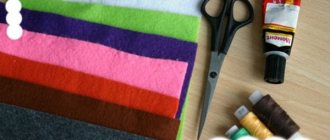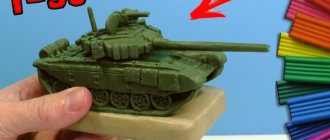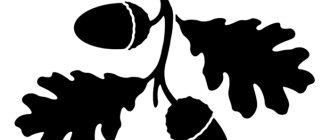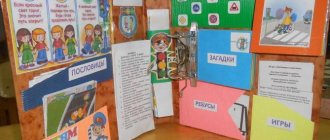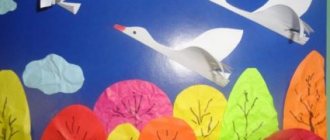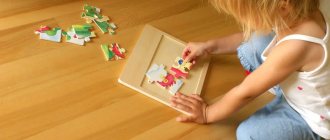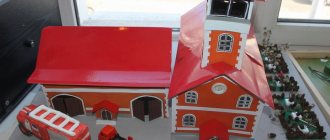Children's drawings for May 9: what to draw for Victory Day
How to draw a picture for May 9? This can be a drawing with paints, pencils, felt-tip pens, or crayons. You can also use other techniques: spraying, appliqué elements, fingerprinting.
In accordance with the theme of the holiday, the drawing may contain military equipment, weapons, soldiers, tanks, fireworks, and an eternal flame. Often they simply depict bouquets of carnations and date inscriptions.
For an impressive image, you can show fireworks on a black sheet using crayons.
Simple pencil drawings that even small children can draw.
How to draw a poster for May 9th for school with your own hands step by step - master class, photo
On the eve of Victory Day, many educational institutions hold ceremonial events dedicated to the memory of all those who bravely fought for peace at the cost of their lives. Thus, primary school students take part in the design of a bright wall newspaper, a poster - with photographs, newspaper clippings, notes about warriors, hero cities, and thematic drawings. How to draw a poster for May 9, 2021 for school with your own hands? We offer you to master a simple master class with step-by-step photos of a bright poster in honor of the great Victory Day.
What materials are needed for a school poster for Victory Day on May 9:
- large sheet of whatman paper (A1 format)
- sheets of paper (A4 format)
- colored paper (black, orange)
- orange gouache
- black marker
- black tea (bags)
- scissors, ruler, pencil, brush
- glue
Do-it-yourself step-by-step design of a poster for school in honor of May 9, photo:
- First, let's make a frame for the future poster. Black and orange paper should be cut into thin strips (0.5 cm wide).
- Glue the cut colored strips, alternating, along the edge of a sheet of Whatman paper - you get a St. George’s ribbon. Be sure to leave some space at the top to place your title.
- We draw a beautiful title on the chosen topic with a simple pencil and color it with orange gouache. We outline the contours of each letter with a black marker to give the inscription expressiveness.
- Now let's take care of filling the poster. In our case, the main theme is hero cities - you will need to prepare in advance and print out materials (photos and texts) on sheets of paper.
- For greater effect, each leaf can be given an “old” look. We tear off the edges of the sheets a little so that they turn out “carelessly” uneven - of course, the text should not be damaged.
- We crumple the sheets with our hands.
- Immediately smooth it out on a flat surface.
- We dip each sheet in strong tea leaves, after 15 minutes we take it out and dry it with an iron. Such a tea “bath” will artificially “age” the paper.
- We glue the colored leaves to the Whatman paper in any order - as your imagination dictates. When composing the composition, we make sure that the text on the sheets can be read freely.
- As decoration, you can use images of orders, stars and other attributes - we place the pictures on the free areas of the poster.
- Such a wonderful poster for Victory Day 2021 can easily be made by elementary school students, surprising and delighting their parents with the fruits of their creativity.
Drawing for May 9th for school: drawing for the 75th anniversary of the victory
It is not difficult to prepare a drawing for school on May 9; any child can make his work unique. A holiday poster can be made with pencils, paints, or supplemented with applique. You just need to learn how to draw a few of the main symbols of this day.
It would be symbolic to depict the eternal fire in the drawing and complement it with flowers
For younger children, consider a simpler option.
Everyone knows that the dove is a symbol of peace, so it can also be present in the picture dedicated to Victory Day.
Drawing a dove is not difficult and even schoolchildren in grades 1 and 2 can handle it.
The dove fits perfectly into the drawing for May 9th at school.
By combining some elements, you can create a beautiful drawing and then paint it with watercolors.
Materials:
- Drawing paper
- Pencil
- Brush
- Ruler
- Eraser
- Water in a glass
If you can’t draw an even star, use a template. Which you can print and transfer to your drawing.
Let's start drawing with a star. Using an object, draw a circle in the center and another one inside it.
Draw additional rays between the rays of the star and separate them with lines. Draw a hammer and sickle inside the star.
Rarely are drawings for May 9 complete without an image of the St. George ribbon.
Using parallel lines, draw a ribbon that goes behind the star. The tape will split into strips.
Above the star, make a large inscription of the number 9 and below the word “May”
The rest of the sheet space can be filled with different elements - flowers, fireworks.
With the help of paints you can make the drawing bright.
Ideas for decorating a stand in a preschool educational institution for May 9
One of the tasks of a kindergarten is to use effective forms of work to ensure productive communication between the teacher, children and parents as participants in the educational process. In this regard, information stands come to the aid of the preschool institution. Moreover, they can not only contain some practically useful information for moms and dads (announcements, recommendations for child care), but also cover interesting events in the life of the group, as well as the whole country. An example is a stand dedicated to the Victory Day holiday.
Stands are an important means of interaction between teachers, students and parents
Usually it is hung in the reception area (locker room) so that not only children, but also parents can see pictures and educational information. Such a stand should be bright and colorful. Its specific content largely depends on the age of the students. So, in the junior and middle groups these will mainly be pictures symbols of Victory, along with which you can place simple poems about the war. For example, this option would be suitable:
- What kind of holiday? Author N. Ivanova There are festive fireworks in the sky, Fireworks here and there. The whole country congratulates the Glorious Veterans. And the blooming spring gives them tulips, gives them white lilacs. What a glorious day in May?
In the senior and preparatory groups, children should be actively involved in creating a stand: in collecting materials and decorating. The guys can create drawings on the theme of the Great Patriotic War (this can be done in a group, or the teacher gives homework).
Older preschoolers can fill the stand with their drawings
Also, preschoolers can independently make three-dimensional flowers to decorate the composition, create images of the Eternal Flame, doves, etc. using appliqué (for example, a mosaic made from napkins).
The stand can be decorated with voluminous homemade flowers - carnations or tulips
You can involve your parents in creating the stand: after all, almost every family has ancestors who participated in the Second World War. Moms and dads can bring their photographs with brief accompanying information (especially great if we are talking about a feat).
Parents should be actively involved in creating the stand - they can bring photos of ancestors who participated in World War II
Since such old photos are family heirlooms, it is better to scan and print them.
The teacher can place on the stand information about fellow countrymen - WWII heroes or about child heroes.
The stand seems to unite wartime children and modern preschoolers
It is also good to use postcards, posters, pictures of the war and post-war years. Of course, finding the originals will be very problematic, so the images can be taken from the Internet and printed.
Wartime postcards and posters will be indispensable for filling the stand.
A very good option for older preschoolers is to place historical photos on the stand. The only thing is that they should be positive, dedicated to Victory, there is no need to take tragic and terrible images of war. Children should feel not fear, but pride in the Great Victory that their ancestors won.
Photo gallery: a selection of historical photographs on the Victory theme (material for the stand)
Representatives of different fronts walked along the fruiting parade during the 1945 Victory Parade
The act of unconditional surrender of Germany, signed, is evidence of its complete defeat in the war
The first Victory Parade took place on June 24, 1945
The ceremonial historical fireworks in honor of the Victory took place on May 9, 1945 at 22.00
Soviet soldiers fought in Berlin, the capital of Germany, in May 1945
The hoisting of the Soviet flag on the Reistag - a symbol of Victory over the Nazis
Liberation of Czechoslovakia, Prague, May 5, 1945
The holiday stand may also contain modern photographs: depicting children’s respect for veterans, the respectful attitude of modern military personnel towards their predecessor colleagues, photographs of the Victory Day parade, ceremonial fireworks, etc.
Photo gallery: a selection of modern photos for the festive stand
and the photo should definitely reflect the theme “Children respect the heroism of veterans”
Every year on May 9, the Victory Parade is held on Red Square in Moscow.
On the evening of May 9, in any Russian city you can see the ceremonial fireworks. The feat of fallen soldiers is an example for modern military personnel.
An interesting idea is to decorate the Stand in honor of Victory Day with triangle envelopes (letters from the front). To make them look more realistic, the paper can be “aged” first. To do this, the sheets are covered with instant coffee (of course, the prepared drink, not the powder) and laid out on the table until completely dry. Similarly, you can “age” just a sheet of paper with a poem, which will also become part of the stand.
Letters from the front should be artificially aged - this way they will look more realistic
Video: how to age paper using coffee
An important part of the design is creating a beautiful inscription; it will become the name of the stand. In addition to the usual options “Victory Day”, “Happy Victory Day!”, “May 9”, you can use the following options: “Thank you!”, “We are proud! We remember! We honor!”, “As long as we remember the past, we have a future”, “Your feat is immortal.”
Photo gallery: beautiful inscriptions for the stand
The inscription on a symmetrical design (star and ribbon) looks very beautiful
The inscription is accompanied by an interesting symbol - a star turning into a St. George ribbon
Preschoolers should learn these wonderful words well. White letters on a black background look very solemn. The simple word “Thank you” with an ellipsis against the backdrop of a fluttering St. George’s ribbon is filled with deep meaning.
As for the base for the stand, it can be not only a hard surface (for example, foam, etc.), but also dark satin fabric hung on the wall.
Drawing for kindergarten on May 9: simple examples with photos
This holiday for adults can be both joyful and sad at the same time. Kids in kindergarten will not understand the essence of the holiday, but from this age they can already be shown and told the general meaning of this day.
It is for this purpose that many gardens prepare drawings for May 9th. They don't have to be complicated. Let them contain several main elements of this day: an eternal flame, a star, a tank, an airplane, soldiers, flowers. The child can choose what is easier and more enjoyable for him to draw.
A simple option on how to draw a tank
You can just as easily depict a military plane in the sky.
And even the younger group can handle such a simple plane. The drawing for May 9 will be thematic with the addition of a military aircraft.
Simple elements in the form of fireworks will help decorate any drawing, and kids will love making such patterns.
Wall newspapers for the holidays
In this section we have collected author's wall newspapers with such significant dates as New Year, February 23, March 8, May 9, September 1. All wall newspaper templates are copyrighted and are in A2 format (4 A4 sheets). They must be printed on a color printer and glued together. You can also write down your information (congratulations, poems, useful notes) in the free fields.
| Wall newspaper “Happy March 8th!” The archive contains 4 A4 sheets plus the original. You need to print and glue. |
| Wall newspaper “February 23 – Defender of the Fatherland Day.” The archive contains 4 A4 sheets plus the original. You need to print and glue. |
| Wall newspaper "Happy Valentine's Day!" The archive contains 4 A4 sheets plus the original. You need to print and glue. |
| Wall newspaper “Happy New Year and Merry Christmas!” The archive contains 4 A4 sheets plus the original. You need to print and glue. |
| Wall newspaper “Happy New Year!” The archive contains 4 A4 sheets plus the original. You need to print and glue. |
| Wall newspaper "December 12 - Constitution Day of the Russian Federation." The archive contains 4 sheets of A4 format. You need to print and glue. |
| Wall newspaper for the beginning of the school year “September 1 is the day of knowledge” for children. The archive contains 4 sheets of A4 format. You need to print and glue. |
| Wall newspaper for the beginning of the school year “September 1 - Day of Knowledge” for children. The archive contains 4 sheets of A4 format. You need to print and glue. |
| Wall newspaper-memo for parents “Behavior near water.” The archive contains 4 sheets of A4 format. You need to print and glue. |
| Wall newspaper for kindergarten graduation “Goodbye, kindergarten!” The archive contains 4 sheets of A4 format. You need to print and glue. |
| Wall newspaper for the holiday of May 9 “Victory Day” for children. The archive contains 4 sheets of A4 format. You need to print and glue. |
Wall newspapers for holidays are used as wall decorations in children's and public institutions. Also, a wall newspaper can have an educational character if it is supplemented with relevant entries and drawings. So, you can make a wall newspaper yourself for any holiday by coloring it and selecting the necessary poems. Using the scrapbooking technique, you can decorate a wall newspaper or a template for it. Or you can simply download ready-made templates for wall newspapers and posters for any holiday, print them on a color printer, glue all the parts together and add the necessary notes.
PS All graphic materials presented in this section belong to the author of the Vkusnyasha.ru portal - E. Nefedova, and are intended exclusively for use in kindergartens, schools and other children's institutions. Any copying, distribution or republication is PROHIBITED!
Pencil drawings for children for Victory Day
Among children there are those who like to draw more with pencils, and use paints only as needed. But with pencils you can draw very beautiful, bright and neat drawings for May 9th.
A simple image of tulips will help decorate any holiday design.
It is more traditional to see carnations on May 9th. They can also be drawn with a pencil
Examples of drawings for Victory Day in pencil
How to draw a wall newspaper poster for May 9th yourself, templates?
On May 9 , it will be relevant to create a wall newspaper at school on the topic “ Victory Day ”.
Students, by drawing and creating themes for the wall newspaper, will understand even more the value and importance of Victory in the Second World War, which came with losses, exhaustion, trials, losses. The heroes of that war gave their lives so that we could now breathe freely, admire the sun and sky.
Years later, the event is somewhat erased from memory, because there are fewer and fewer living eyewitnesses - veterans, home front workers. Moreover, it will be useful for schoolchildren to create a wall newspaper on their own and reconstruct the events of those years in order to know the heroes and understand how important peace is.
What can you take as a basis and with what images can you use templates?
These are the options that are perfect for a wall newspaper.
✓ Heading at the top of the wall newspaper (“Victory in 1945”, “Great Victory”, “Feat of Heroes in the Second World War”, etc.
) + St. George's ribbon on the left (pasted from applique / natural rep / hand-drawn with pencils and paints) + poems + drawings (“carnation”, “carnation pigeon”, “army star with five points and sides”, “dove with a twig”, “ dove of peace”, “eternal flame”, below there is a thank you inscription “We remember!”, “Thank you for peace!”, etc.
✓ Heading + St. George's ribbon + newspaper clippings (drawn or scanned) + poems + drawings + inscription “1941 - 1945.”
✓ Title + St. George's ribbon + a story in your own words about the war or an excerpt from an essay + a thank you note + drawings.
✓ The inscription "1941 - 1945" instead of a title + photographs of front-line soldiers + painted flowers + St. George's ribbon, etc.
Templates:
- More templates:
- Step-by-step drawing with fireworks for a template on a wall newspaper:
Source: https://www.bolshoyvopros.ru/questions/1871875-kak-narisovat-stengazetuplakat-k-9-maja-samostojatelno-shablony.html
Victory symbol “St. George’s Ribbon”: how to draw
In many pictures you can see the St. George ribbon. How to draw such an element interests both children and adults. The ribbon can be depicted in different ways in the drawings - smooth, winding, or even create the number 9.
Where and how to depict the St. George ribbon you can decide for yourself. It can have a variety of shapes or simply decorate the edge of the design.
St. George's ribbon: draw with a pencil
You can draw the St. George's ribbon with a pencil, and then color it in any way.
First, draw two parallel lines and then a couple more so that they intersect with the previous ones. Connect the two outer ones with smooth lines, depicting a semi-oval. Repeat the process with the internal lines and work on the details, erasing the excess.
Draw stripes along the entire length of the ribbon, painting three stripes black and the rest orange.
You can depict the St. George ribbon in the form of the number 9 as follows.
In the center of the sheet, draw the number 9 and add volume to it. Draw flowers near the number.
Near the flowers we draw leaves and work on the branches. Draw the number in stripes and paint black every other one. Add the word “May” next to it and draw fireworks around it.
Beautiful drawings for May 9: how to draw for Victory Day
If you carefully work out all the details, carefully color each element, then from a simple drawing for May 9, you can get a beautiful postcard. They can be presented to veterans as a memorable souvenir, supplemented with beautiful touching poems.
Children's drawings for the 75th anniversary of the victory
Anyone who wants to become part of that wonderful day can draw victory on the eve of such a Great holiday. This year everyone will celebrate the 75th anniversary of the victory. So many years have passed, but no one and nothing has been forgotten. In this drawing you can depict everything that concerns the war, victory, but indicate the year or make the signature “75 years”. This will give solidity to the drawing.
Drawing competition dedicated to Victory Day on May 9
In high school, children already have more information about what Victory Day means to everyone. Therefore, every year schools hold drawing competitions so that both schoolchildren and adults can appreciate the work and effort of the participants. For the competition, each child tries to choose the topic of their work more carefully and work out every detail.
Wall newspaper for May 9
Some interesting events of the Second World War
The Second World War (hereinafter referred to as the war) began on September 1, 1939 and lasted until September 2, 1945 and was fought on the territory of 40 states. 61 countries took part in the hostilities and 60 million people died in this bloodthirsty war. During the 6 years of hostilities, a lot of interesting events took place, which most likely almost no one knows about.
1. At the beginning of World War II, the USSR simply did not have enough tanks, so the leadership decided in special cases to take the enemy’s bluff and “turn” ordinary tractors into tanks. Such a special incident occurred during the defense of Odessa from Romanian units. The tanks were lined with sheets of metal and launched into battle at night to the sound of a siren. Out of fear, the Romanians fled. For this he was nicknamed Ni-1 (For fright)2. An interesting incident occurred in 1943 at the Battle of Kursk. 1,000 of our and enemy planes flew in the sky and fought. In one of these battles, 4 German Bf-109 fighters met an Il-2 attack aircraft in the sky, nicknamed the “Black Death” by the Germans. All the German fighters took turns firing a series of rounds at the tail of the Il-2, but the attack aircraft flew as if nothing had happened. The German flight commander asked the pilot why the attack aircraft did not fall, to which the pilot replied: “Mr. Colonel, you can’t bite a hedgehog in the ass!”
3. An interesting incident occurred during the American landing on the Mariana Islands in June 1944. Only the launched Japanese aircraft carrier Taiho rushed to the aid of the allies. The American submarine Albacore decided to rush across the aircraft carrier and, upon reaching attack range, fired 2 torpedoes. The Taiho launched fighters from the ship to attack from the air. Seeing the torpedo, one of the Japanese pilots rushed at it and thereby stopped it. but this did not save the pride of the imperial Taiho fleet, because the second torpedo blew up the aircraft carrier on the first strike, which happens extremely rarely.
4. An interesting situation occurred with the heroic blockade of Leningrad. Indeed, in September 1941, German troops under the command of Wilhelm von Leeb advanced on Leningrad, overcoming the resistance of Soviet troops. On September 15, the Germans captured Uritsk and were ready to take Leningrad with a powerful attack.
But help for our heroic city came not from our fronts, but from Hitler himself, because he ordered von Leeb to remove the 41st Panzer and 8th Air Corps from the front, which were the main power of the army on this front, Hitler decided to starve the city to death, but that was not the case, and in January 1944 the Germans were thrown back from the city many kilometers ago.
5. After the end of the war, Stalin reported that about 7 million people died at the front; in fact, this figure was made up, since no one wanted to count the dead. And only with the arrival of Khrushchev the death toll increased to 30 million. But in fact, the total loss of the USSR in the war was about 43 million, of which about 26 million were soldiers.
Why was one dog carried in the arms of a Stalinist overcoat at the Victory Parade on June 24, 1945? During World War II, trained dogs actively helped sappers clear mines. One of them, nicknamed Dzhulbars, discovered 7,468 mines and more than 150 shells while clearing mines in European countries in the last year of the war.
Shortly before the Victory Parade in Moscow on June 24, Dzhulbars was injured and could not participate in the military dog school. Then Stalin ordered the dog to be carried across Red Square on his overcoat. Already 70 years have passed since the Great Victory over the Nazis in World War II.
The war, which lasted from 1939 to 1945, claimed millions of lives, but still ended in victory (naturally thanks to the Soviet people)
During the Great Patriotic War, about sixty thousand dogs were drafted into the army, not only shepherd dogs, but also other breeds, including large mongrels. Of these, 168 units were formed.
Dogs at the front were used for a variety of purposes. First of all, they served both as guards and as combat guards. Dogs were often used in ambushes and secrets.
There were also special dogs trained to search for the hiding places of enemy snipers, ambulance dogs, and signal dogs.
- Dogs at war.
- How many words have been said, Maybe someone's muse is tired Talking about the war And disturbing soldiers' dreams It just seems to me Little has been written to offend About the dogs - fighters Who protected us during the war. Nicknames have been erased from memory Now I can't even remember the face We, who came later, know nothing at all Only the gray-haired veteran Still remembers the dog sled that dragged him to the medical battalion
- From the battlefield once it.
S. Eroshenko.
Sled dogs and ambulance dogs. The ambulance dogs found our wounded soldiers in the forests and swamps and brought medical help to them. In addition, they carried small backpacks with all the necessary medications needed to provide first aid.
During the Great Patriotic War, ambulance dogs pulled more than 700 thousand wounded soldiers from the battlefield.
In total, during the hostilities, about 15 thousand dog sleds were formed, which delivered wounded soldiers to shelter, where they could be provided with urgent medical care.
In winter, on sledges and in summer, on special carts, under fire and explosions, about 700 thousand seriously wounded were taken from the battlefield, and 3,500 tons of ammunition were transported to combat units.
Mine detection dogs.
Mine detection dogs - there were about 6 thousand of them - were discovered, and sapper leaders neutralized 4 million mines, landmines and other explosives. The Leningrad collie Dick is famous. In his personal file it is written: “Called up for service from Leningrad and trained in mine detection.
During the war years, he discovered more than 12 thousand mines, took part in demining Stalingrad, Lisichansk, Prague and other cities. Dick accomplished his main feat in Pavlovsk.” It was like that. An hour before the explosion, Dick discovered a two and a half ton landmine with a clock mechanism in the foundation of the palace.
After the Great Victory, the legendary dog, despite multiple wounds, was a repeated winner of dog shows. The veteran dog lived to a ripe old age and was buried with military honors, as befits a hero.
Communication dogs.
Communication dogs - in difficult combat situations, sometimes in places impassable for humans, delivered over 120 thousand combat reports; to establish communications, they laid 8 thousand km of telephone wire (for comparison: the distance from Berlin to New York is 6,500 km).
Sometimes even a seriously wounded dog crawled to its destination and completed its combat mission. The German sniper shot out both ears of the messenger dog Alma with the first shot, and shattered the jaw with the second. And yet Alma delivered the package. The famous dog Mink for 1942-1943. delivered 2,398 combat reports. Another legendary dog, Rex, delivered 1649 reports.
He was wounded several times, crossed the Dnieper three times, but always reached his post.
Dogs are tank destroyers.
Dogs are tank destroyers. Not the most pleasant dog profession that appeared during the war. These dogs were trained for one and only task in their lives - blowing up enemy tanks.
To do this, they were trained not to be afraid to crawl under moving tanks. Before the mission, they were wearing special bags with mines. And as soon as the dog was under the armored vehicles, the mine exploded. About 300 enemy tanks were destroyed in this way during the war.
From the report of the commander of the 30th Army, Lieutenant General Lelyushenko, dated March 14, 1942: “During the defeat of the Germans near Moscow, the enemy tanks launched into the attack were put to flight by the dogs of the destruction battalion.
The enemy is afraid of anti-tank dogs and specifically hunts for them.”
The German shepherd Dzhulbars was a participant in the Great Patriotic War. He served in the 14th assault engineer brigade. The only dog awarded the medal "For Military Merit".
Thanks to his excellent instincts, 7,468 mines and more than 150 shells were cleared in Czechoslovakia, Austria, Romania and Hungary (from September 1944 to August 1945).
He also participated in clearing mines from the palaces above the Danube, the cathedrals of Vienna and the castles of Prague.
At the historical Victory Parade on July 24, 1945, all fronts of the Great Patriotic War and all branches of the military were represented.
But not everyone knows that at that parade, following the combined regiments of the fronts, the Navy regiment and columns of military equipment, dogs walked along Red Square with their handlers. At that historical parade, the country’s chief dog handler, Lieutenant Colonel Mazower, walked behind the “box” of soldiers with dogs.
He was allowed not to mark a step and not to salute the commander-in-chief, since he was carrying in his arms a soldier of the 14th assault engineer brigade - a dog named Dzhulbars.
Dogs walked with man, side by side, and in difficult times they came forward. They shared a trench and rations with a man. They worked and died instead of people. In gratitude for their feat, monuments were erected to the dogs. On May 28, 2011, in Volgograd, on Chekistov Square, a monument to the demolition dogs who defended Stalingrad during the Great Patriotic War was unveiled.
A unique monument to 150 border dogs who “torn” an entire regiment of fascists in hand-to-hand combat. This battle, the only one in the history of world wars and conflicts, between people and dogs took place in the very center of Ukraine many years ago.
- A monument to a front-line dog was unveiled on Poklonnaya Hill in Moscow.
Source: https://infourok.ru/stengazeta-na-maya-1410805.html

